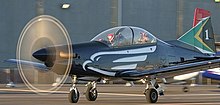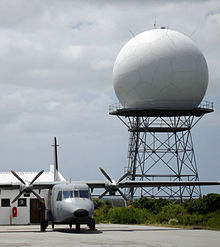South African Air Force
|
South African Air Force |
|
|---|---|
 Flag of the SAAF |
|
| Lineup | February 1, 1920 |
| Country |
|
| Armed forces | South African National Defense Force |
| Armed forces | air force |
| Strength | 9250 |
| headquarters | Pretoria |
| motto | " Per aspera ad astra " ( lat. "Through the rough to the stars") |
| management | |
| Chief of the Air Force | Lieutenant General Fabian Zimpande (Zakes) Msimang |
| Deputy Chief of the Air Force | Major General Gerald Malinga |
| General Officer Commanding Air Command | Major General Wiseman Simo Mbambo |
| insignia | |
| Aircraft cockade |
 
|
| National emblem ( vertical stabilizer ) |
|
The South African Air Force ( Engl. : South African Air Force , abbreviated SAAF ) is the air force of the Armed Forces of the Republic of South Africa and with the best equipped south of the Sahara .
history
The origins of today's South African Air Force go back to 1912, when an Aviation Corps was set up. During the First World War, however, South African flight personnel were mainly used in the Royal Flying Corps (RFC) of what was then the British mother country. The most successful South African "ace" was Andrew Frederick Weatherby Beauchamp Proctor , one of the most successful pilots of the RFC at all.
Shortly after the fighting ended, the Air Force was renamed the South African Air Force on February 1, 1920 . Just two years after their founding, they were used operationally for the first time during unrest by white miners.
As part of the worsening general political weather situation from the mid-1930s, the armed forces were significantly expanded, but the outbreak of World War II in Europe hit the SAAF relatively unprepared.
Again, South Africa made a significant contribution to the war effort in all parts of the British Empire . As a result, South Africa, which is far from the theaters of war, saw a massive expansion, especially in training flight operations . In September 1941, shortly before the war expanded into the Pacific, there were 38 flight schools and almost 1,800 aircraft in total in the service of the SAAF. In addition to the defense of southern Africa (submarine warfare), the SAAF played an important role in the fighting in North Africa against the Africa Corps and was also mainly deployed in Europe.
The first missions after the war were the deployment of 20 crews to the RAF as part of the Berlin Airlift and shortly after its end the 2nd Squadron , which is still active in the Korean War, was subordinated to the 18th Fighter Bomber Wing of the US Air Force (USAF), where many of their pilots won American awards.
During this time, in 1951, a few years after the founding of the independent USAF, the SAAF became independent within the Union Defense Force (UDF) in South Africa . In 1958 the SAAF became part of the South African Defense Force . In the 1950s there was a downsizing and in the early 1960s, with the founding of the Republic of South Africa, a further reorganization into three task-specific groups , similar to the structure of the RAF, for missions over land and sea as well as maintenance.
In the meantime the apartheid policy was established and as a result of this South Africa became more and more politically isolated and finally found itself confronted with a UN arms embargo. From the mid-1960s to the end of the 1980s, the SAAF regularly supported the army in various wars and conflicts in Angola, which was initially Portuguese and what is now Namibia, which was then administered by South Africa . Due to the embargo imposed on South Africa, aircraft and helicopters (e.g. Atlas Cheetah , Atlas Oryx or Denel AH-2 Rooivalk ) had to be further developed or redeveloped from models already in use.
After the end of apartheid and the first general elections in 1994, the SAAF became part of the South African National Defense Force and significantly restricted both in terms of equipment and manpower. Now, however, new modern equipment came back into the country.
Current equipment
Planes
Status: end of 2013
| Aircraft | origin | use | version | active | Ordered | Remarks | |
|---|---|---|---|---|---|---|---|
| Warplanes | |||||||
| Saab JAS 39 Gripen |
|
Multipurpose attack aircraft trainer |
Gripen C Gripen D |
17 9 |
|||
| Transport, mission and training aircraft | |||||||
| Cessna 208 |
|
Electronic warfare transport aircraft |
1 9 |
||||
| Douglas DC-3 |
|
Electronic warfare maritime patrol transport aircraft |
1 4 3 |
||||
| Lockheed C-130 Hercules |
|
Transport plane | C-130B | 6th | |||
| CASA C-212 Aviocar |
|
Transport plane | 3 | ||||
| King Air |
|
Liaison aircraft | King Air 200 King Air 300 |
4th | |||
| Pilatus PC-12 |
|
VIP transport machine | 1 | ||||
| BAE Hawk |
|
Trainer aircraft | Hawk 120 | 24 | |||
| Pilatus PC-7 |
|
Trainer aircraft | PC-7 MkII Turbo Traine | 35 | |||
helicopter
Status: end of 2013
| Aircraft | origin | use | version | active | Ordered | Remarks |
|---|---|---|---|---|---|---|
| Agusta A109 |
|
Light multipurpose helicopter | A109 LUH | 28 | ||
| MBB / Kawasaki BK 117 |
|
Liaison helicopter | 6th | |||
| Atlas Oryx |
|
medium transport helicopter | 46 | |||
| Denel AH-2 Rooivalk |
|
Attack helicopter | 12 | |||
| AugustaWestland Lynx |
|
Board helicopter | Super Lynx 300 | 4th | Operated by the South African Navy |
Missiles
- Kentron V3 - short-range heat-seeking air-to-air missiles
- Kentron V4 R-Darter - medium-range radar-guided air-to-air missile
Air bases
The SAAF calls the larger military airfields Air Force Base (AFB), and there are also the smaller Air Force Stations. As a rule, only the active flying units and their operational patterns are listed for the following positions.
- AFB Bloemspruit , Bloemfontein , Free State Province , base for combat and training helicopters at the 16th Squadron (Rooivalk) and the 87th Helicopter Flying School (various types)
- AFB Durban , Durban , KwaZulu-Natal Province , base of two SAR helicopters ( Atlas Oryx ) with the 15th Squadron (to be downgraded from an Air Force Base to an Air Force Station)
- AFB Hoedspruit, Hoedspruit , Limpopo Province , base of liaison helicopters in the 19th Squadron (Alouette III, Oryx)
- AFB Langebaanweg, Langebaan, Western Cape Province , training base with the Central Flying School (PC-7)
- AFB Makhado, Louis Trichardt, Limpopo Province, main base for combat aircraft in the 2nd Squadron (Gripen) and the 85th Combat Flying School (Hawk)
- AFB Overberg, Bredasdorp , Western Cape Province , test and development center, international Gripen Fighter Weapon School (from 2013)
- AFB Swartkop, Pretoria (managed from AFB Waterkloof), u. a. a location of the SAAF museum (see photo)
- AFB Waterkloof , Pretoria, Gauteng Province, main base of operations for the transport aircraft with the 21st, 28th, 41st, 44th and 60th Squadron (VIP aircraft, C-130, liaison aircraft, C-212 / CN-235, 707)
- AFB Ysterplaat, Cape Town , Western Cape Province, transport helicopters and patrol, transport and early warning aircraft in the 22nd and 35th Squadron (Oryx / Lynx, C-47) as well as another location of the SAAF Museum
- AFS Port Elizabeth , Port Elizabeth , Eastern Cape Province , base of a unit of the 15th Squadron deploying four SAR helicopters ( BK 117 ) and home to the Territorial Reserve Squadron 108 Squadron, which serves various civil light aircraft in the role of supply transport.
Web links
- Official site of the South African Air Force (English)
- The South African Air Force at GlobalSecurity.org (English)
- Overview of the armed forces of the South African National Defense Force at GlobalDefence.net
Individual evidence
- ↑ World Air Forces 2014. (PDF; 3.9 MB) In: Flightglobal Insight. 2014, archived from the original on December 25, 2013 ; accessed on March 26, 2014 (English).
- ↑ World Air Forces 2014. (PDF; 3.9 MB) In: Flightglobal Insight. 2014, archived from the original on December 25, 2013 ; accessed on March 26, 2014 (English).







